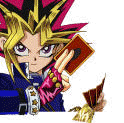 |
Marketing History of Yu-Gi-Ohand the Companies Behind the Game |
 |
Marketing History of Yu-Gi-Ohand the Companies Behind the Game |
Yu-Gi-Oh! Marketing HistoryYu-Gi-Oh!, the King of Games, first appeared in 1996 in a comic series (manga) by Kazuki Takahashi. It was carried in Shonen Jump, Japan's largest weekly comic magazine. Shonen Jump is published by Shueisha Inc.A 27-episode television series accompanied by a collectible card game was a great hit in Japan in 1998. Yu-Gi-Oh it is currently a popular TV series in Japan on TV Tokyo and is produced there by NAS (Nihon Ad Systems). Konami, a Japanese company, controls Yu-Gi-Oh trading card and video game rights worldwide. Their company is well known here for its work with Teenage Mutant Ninja Turtles video games in the 1980's and 1990's as well as its 1981 U.S. video arcade game, Frogger. In April 2002 Konami started shipping Yu-Gi-Oh! Gameboy video games. Konami of America, Inc. is Konami's U.S. presence. 4Kids Entertainment obtained the U.S. merchandizing and television rights to Yu-Gi-Oh!. from Konami in Japan on 8 May 2001. Since then it appears a wider license has been granted to them. 4Kids is no stranger to this business as they similarly brought Pokeman from Japan to the United States. 4Kids Entertainment rapidly partnered with Warner Brothers. and Yu-Gi-Oh! premiered on Kids' WB television network in September 2001. On December 21, 2001, 4Kids Entertainment granted Mattel exclusive worlwide license (with the exception of Asia) to manufacture and market Yo-Gi-Oh action figures and accessories, board games, puzzles, vehicles, playsets, activity sets, role playing products, youth electronics and ViewMaster products. Mattel began shipping its production in April 2002.
|
|
A few other game abbreviations you may encounter are:
Yu-Gi-Oh is also protected by several Japanese Patents and U.S. Copyrights and Trademarks.
Many of the licenses surrounding Yu-Gi-Oh were announced in Press Releases.
Wizards of the Coast (WotC) had the Pokemon card license and was recently awarded the Star Wars trading card license. Some were surprised the Yu-Gi-Oh license went to Upper Deck instead of WotC. Reports indicate the decision may have been made by Hasbro (they own WotC) to go with Star Wars to fill out some of their existing Star Wars licenses, vs. Yu-Gi-Oh. That decision may have placed WotC in poor position. Pokemon continues to slide downhill and Yu-Gi-Oh may have been a more attractive property of WotC than Star Wars.
Wizards of the Coast, the U.S. firm behind Pokemon, says they planned it for kids 8 to 11 years old. Yu-Gi-Oh! The Gathering is designed for 11 and older with many kids 16 or over playing the game. The wider age range (5 years vs. 3 years) provides a large audience of potential users.
Online message boards include some comments from advanced gamers who wish Wizards of the Coast had won the Yu-Gi-Oh license. They think the game would have been more jazzed up and better received by older teens and adults.
New cards are frequently added by the firms producing Collectible Card Games. Over time the game grows, evolves and strategies change. This makes them different from static games like Chess, Risk and Monopoly.
A few examples of the way the game was "toned down" in translation for the U.S Market were provided by an Epinions Reviewer.
Japan-English Black Magician-Dark Magician Dragon Egger-Ryu-Ran (an attempt to look authentic) Dark Knight Gaia-Gaia the Fierce Knight Sacrifice-Relinquished Killer Tomato-Mystic Tomato Cyclone-Mystical Space Time (one of my least favorites)This reviewer feels since few very young children play the game, it could have been more interesting to the older children if the Japanese version had been more closely followed.
Its obvious that Pokemon set the stage for Yu-Gi-Oh. Both games came from Japan and while they share no story line or components, a huge audience was introduced to the concept of collectable monster card games by Pokeman. Having been once introduced, it is much easier for them to move across to Yu-Gi-Oh. Its somewhat like being familiar with CD Rom players and moving over to DVD disks. If DVD disks had followed 8 track tapes consumers would have been pretty confused and their adoption would have been much slower. The same is true of Yu-Gi-Oh!. It owes a great debt to Pokemon.
Another Yu-Gi-Oh predicessor was Digimon, a fighting, linkable key chain pet. Built by Bandai, Digimon was a monster training and fighting game. Bandai borrowed heavily from Pokemon in the creation of Digimon. Yu-Gi-Oh is now the benefactor as Digimon also helped prepare many children around the world for fighting monster games.
Three special holographic silver foil embossed cards were bundled with the intial release of the Game Boy version of Yu-Gi-Oh! The Immortal Duelist Soul and will not be available elsewhere. Future releases of this Game Boy game will be packaged with three other cards (seemingly less desireable cards).
Its easy to envision special cards release with movies, fast food places, airlines and other product tie ins. We would anticipate Yu-Gi-Oh! to follow the trends set by other virtual pets. They are rapidly ramping up in the rest of the world (translating and localizing the game for other countries).
We can foresee:
The bottom line is we anticipate continued and rapid diversity on all fronts. At some point in time the game will go into a declining mode, they all do. But even when it begins to go down, it will still have many followers and future generations for a market. Plus they have blazed the trail for other games in the future. Just as they built upon Pokemon, some game will build upon them.

Return to Yu-Gi-Oh Portal